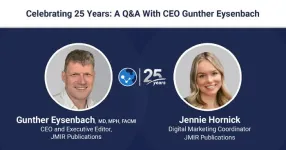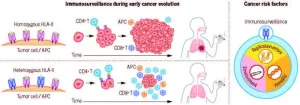(Press-News.org) DURHAM, N.C. – Biomedical engineers at Duke University have uncovered a key link between the spread of antibiotic resistance genes and the evolution of resistance to new drugs in certain pathogens.
The research shows bacteria exposed to higher levels of antibiotics often harbor multiple identical copies of protective antibiotic resistance genes. These duplicated resistance genes are often linked to “jumping genes” called transposons that can move from strain to strain. Not only does this provide a mechanism for resistance to spread, having multiple copies of a resistance gene can also provide a handle for evolution to generate resistance to new types of drugs.
The results appeared February 16 in the journal Nature Communications.
Earlier work by the Lingchong You lab has shown that 25% of bacterial pathogens are capable of spreading antibiotic resistance through horizontal gene transfer. They have also shown that the presence of antibiotics does not speed up the rate of horizontal gene transfer, so there must be something else happening that pushes the genes to spread.
“Bacteria are constantly evolving under many pressures, and elevated duplication of certain genes is like a fingerprint left at the crime scene that allows us to see what kinds of functions are evolving really rapidly,” said Rohan Maddamsetti, a postdoctoral fellow working in the laboratory of Lingchong You, the James L. Meriam Distinguished Professor of Biomedical Engineering at Duke.
“We hypothesized that bacteria under attack from antibiotics would often have multiple copies of protective resistance genes, but until recently we didn’t have the technology to find the smoking gun.”
Traditional DNA-reading technology copies short snippets of genes and counts them up, making it hard to determine whether high counts of specific sequences are actually in the sample or if they are being artificially amplified by the reading process. In the past five years, however, complete genome sequencing with long-read technology has become more common, allowing researchers to spot high levels of genetic repetition.
In the study, Maddamsetti and coauthors counted the repetitions of resistance genes present in samples of bacterial pathogens taken from a variety of environments. They discovered that those living in places with higher levels of antibiotic use — humans and livestock — are enriched with multiple identical copies of antibiotic resistance genes, while such duplications are rare in bacteria living in wild plants, animals, soil and water.
“Most bacteria have some basic antibiotic resistance genes in them, but we rarely saw them being duplicated out in nature,” You said. “By contrast, we saw lots of duplication happening in humans and livestock where we’re likely hammering them with antibiotics.”
The researchers also found that the levels of resistance duplication were even higher in samples taken from clinical datasets where patients are likely taking antibiotics. This is an important point, they say, because the increase in copying antibiotic resistance genes also increases the likelihood of bacteria evolving resistance to new types of treatments.
“Constantly creating copies of genes for resistance to penicillin, for example, may be the first step toward being able to break down a new kind of drug,” Maddamsetti said. “It gives evolution more rolls of the dice to find a special mutation.”
“Everyone recognizes there is a growing antibiotic resistance crisis, and the knee jerk reaction is to develop new antibiotics,” You added. “But what we find time and again is that, if we can figure out how to use antibiotics more efficiently and effectively, we can potentially address this crisis much more effectively than simply developing new drugs.”
“The majority of antibiotics used in the United States are not used on patients, they’re used in agriculture,” You added. “So this is an especially important message for the livestock industry, which is a major driver of why antibiotic resistance is always out there and becoming more serious.”
This work was supported by the National Institutes of Health (R01AI125604, R01GM098642, R01EB031869).
CITATION: “Duplicated Antibiotic Resistance Genes Reveal Ongoing Selection and Horizontal Gene Transfer in Bacteria,” Rohan Maddamsetti, Yi Yao, Teng Wang, Junheng Gao, Vincent T. Huang, Grayson S. Hamrick, Hye-In Son & Lingchong You. Nature Communications, Feb. 16, 2024. DOI: 10.1038/s41467-024-45638-9
Online: https://www.nature.com/articles/s41467-024-45638-9
# # #
END
Copies of antibiotic resistance genes greatly elevated in humans and livestock
Study finds a smoking gun for the spread and evolution of antibiotic resistance
2024-02-22
ELSE PRESS RELEASES FROM THIS DATE:
Study shows how local fishers respond to climate challenges
2024-02-22
BEAUFORT, N.C. – When it comes to protecting a crucial resource in the face of changing conditions, it’s important to know how the humans reliant on that resource have organized themselves. Especially if there isn’t a lot of government supervision.
A new study of small-scale fisheries in Mexico’s Gulf of California has found that the fishers’ response to a changing climate can be strongly influenced by what they fish for and how they’re organized. The work appears in the January 2024 issue of Global Environmental Change.
“When we ...
Cooler, wetter parts of Pacific Northwest likely to see more fires, new simulations predict
2024-02-22
CORVALLIS, Ore. – Forests in the coolest, wettest parts of the western Pacific Northwest are likely to see the biggest increases in burn probability, fire size and number of blazes as the climate continues to get warmer and drier, according to new modeling led by an Oregon State University scientist.
Understanding how fire regimes may change under future climate scenarios is critical for developing adaptation strategies, said the study’s lead author, Alex Dye.
Findings were published today in JGR Biogeosciences.
Dye, ...
U.S. Department of Energy awards Argonne National Laboratory $4 million for energy-efficient microchip research
2024-02-22
While the microchips inside electronic devices like cell phones and computers are incredibly small, transistors — the tiny electrical switches inside of microchips — are approaching the atomic level. Today’s microchips pack over 100 million transistors in an area the size of a pin head.
Despite their almost unimaginable size, the total number of such microelectronic devices consume an enormous amount of energy, which is growing exponentially. Predictions indicate that 20% of the world’s energy could be consumed ...
Less invasive early lung cancer study receives Top 10 Clinical Research Achievement Award
2024-02-22
A Weill Cornell Medicine-led research team has been awarded a 2024 Top 10 Clinical Research Achievement Award from the Clinical Research Forum in recognition of an influential 2023 New England Journal of Medicine study on early-stage lung cancer resection.
The award is one of 10 given annually by the Clinical Research Forum for highly innovative and clinically translatable research with the potential to provide major benefits to patients. The Washington, D.C.-based organization is an influential advocate for government funding of clinical research and the interests of American clinical research institutions generally. The winners will present their award-winning ...
Releasing “brakes” in the brain
2024-02-22
When certain connections in the brain do not function correctly, disorders such as Parkinson’s disease, dystonia, obsessive-compulsive disorder (OCD), and Tourette’s syndrome may result. Targeted stimulation of specific areas in the brain can help alleviate symptoms. To pinpoint the exact therapeutic target areas of the brain, a team led by researchers from Charité – Universitätsmedizin and Brigham and Women’s Hospital analyzed data from patients across the globe who had undergone implantation of tiny electrodes to stimulate ...
JMIR Publications celebrates 25 years of publishing health research
2024-02-22
Join Gunther Eysenbach, the founder, CEO, and executive editor of JMIR Publications, in this new video as he reflects on the company's 25th anniversary and its remarkable journey in the scholarly publishing industry. Eysenbach discusses the inception of the Journal of Medical Internet Research and the driving forces behind creating an open access eHealth journal. He emphasizes the significance of innovation both in content and form, highlighting the company's early adoption of internet-based technologies ...
How discrimination, class, and gender intersect to affect Black Americans’ well-being
2024-02-22
URBANA, Ill. – Black Americans experience racial discrimination as a chronic stressor that influences their quality of life. But it exists in conjunction with other social factors that may modify the impact in various ways. A new study from the University of Illinois Urbana-Champaign explores how discrimination, gender, and social class affect individual well-being and relationship quality for Black Americans.
“It’s well documented that discrimination negatively impacts individual quality of life, but research on how it affects relationships is mixed. Some studies find it has a negative effect, others that it has no effect, and some even find a positive effect, ...
Compound vital for all life likely played a role in life’s origin
2024-02-22
Compound vital for all life likely played a role in life’s origin
A chemical compound essential to all living things has been synthesised in a lab in conditions that could have occurred on early Earth, suggesting it played a role at the outset of life, finds a new study led by UCL researchers.
The compound, pantetheine, is the active fragment of Coenzyme A. It is important for metabolism - the chemical processes that maintain life. Earlier studies failed to synthesise pantetheine effectively, leading to suggestions that it was absent at life’s origin.
In the new ...
Study reveals new insights into immune system role in lung cancer risk
2024-02-22
New York, NY (February 22, 2024)—Recent developments in cancer research have highlighted the vital role of the immune system, particularly in the notable successes of cancer immunotherapy.
Now, a paradigm-shifting study led by researchers at the Icahn School of Medicine at Mount Sinai in New York in collaboration with the University of Helsinki and Massachusetts General Hospital sheds light on how variations in immune genetics influence lung cancer risk, potentially paving the way for enhanced prevention strategies and screening.
The findings were described in the February 22 online issue of Science [DOI number: 10.1126/science.adi3808].
The investigators ...
New Cedars-Sinai study pinpoints why some injured kidneys do not heal
2024-02-22
Cedars-Sinai investigators have discovered why some injured kidneys heal while others develop scarring that can lead to kidney failure. Their findings, detailed in a paper published in the peer-reviewed journal Science, could lead to the development of noninvasive tests to detect kidney scarring and, eventually, new therapies to reverse the condition.
“The key to this discovery was our ability to directly compare injured kidney cells that successfully regenerated with those that did not,” said Sanjeev Kumar, MD, PhD, a nephrologist-scientist in the Board of Governors Regenerative Medicine Institute and the Department of Medicine at Cedars-Sinai and senior author ...
LAST 30 PRESS RELEASES:
Global psychiatry mourns Professor Dan Stein, visionary who transformed mental health science across Africa and beyond
KIST develops eco-friendly palladium recovery technology to safeguard resource security
Statins significantly reduce mortality risk for adults with diabetes, regardless of cardiovascular risk
Brain immune cells may drive more damage in females than males with Alzheimer’s
Evidence-based recommendations empower clinicians to manage epilepsy in pregnancy
Fungus turns bark beetles’ defenses against them
There are new antivirals being tested for herpesviruses. Scientists now know how they work
CDI scientist, colleagues author review of global burden of fungus Candida auris
How does stroke influence speech comprehension?
B cells transiently unlock their plasticity, risking lymphoma development
Advanced AI dodel predicts spoken language outcomes in deaf children after cochlear implants
Multimodal imaging-based cerebral blood flow prediction model development in simulated microgravity
Accelerated streaming subgraph matching framework is faster, more robust, and scalable
Gestational diabetes rose every year in the US since 2016
OHSU researchers find breast cancer drug boosts leukemia treatment
Fear and medical misinformation regarding risk of progression or recurrence among patients with breast cancer
Glucagonlike peptide-1 receptor agonists and asthma risk in adolescents with obesity
Reviving dormant immunity: Millimeter waves reprogram the immunosuppressive microenvironment to potentiate immunotherapy without obvious side effects
Safety decision-making for autonomous vehicles integrating passenger physiological states by fNIRS
Fires could emit more air pollution than previously estimated
A new way to map how cells choose their fate
Numbers in our sights affect how we perceive space
SIMJ announces global collaborative book project in commemoration of its 75th anniversary
Air pollution exposure and birth weight
Obstructive sleep apnea risk and mental health conditions among older adults
How talking slows eye movements behind the wheel
The Ceramic Society of Japan’s Oxoate Ceramics Research Association launches new international book project
Heart-brain connection: international study reveals the role of the vagus nerve in keeping the heart young
Researchers identify Rb1 as a predictive biomarker for a new therapeutic strategy in some breast cancers
Survey reveals ethical gaps slowing AI adoption in pediatric surgery
[Press-News.org] Copies of antibiotic resistance genes greatly elevated in humans and livestockStudy finds a smoking gun for the spread and evolution of antibiotic resistance






